Lake of the Woods

While Du Vernet thought the lake “well deserves its name,” the Lake of the Woods’ English name is likely a mistranslation of the even more precise Ojibwe name Pikwedina Sagainan, the “inland lake of the sand hills.” The northern portion of the lake is full of rocky islands of varying size, while the southern area is an open sheet of mostly shallow water and is today called “la traverse,” or “the Big Traverse” as Du Vernet put it.
The Lake of the Woods has been inhabited by people for thousands of years, with artifacts found near the Big Grassy River suggesting Indigenous habitation in the area occurring at least as far back as 8,000 years ago. From the eighteenth century onward, the Ojibwe people were the principle Indigenous residents of the Lake of the Woods area. The Ojibwe lived in several small communities that each had their own hunting and harvesting territory. They relied on the Lake of the Woods’ vast sturgeon population as one of their main food sources, and also cultivated and collected wild rice, a high calorie type of grass found in the lake’s shallower waters.
The Europeans first reached the Lake of the Woods in the eighteenth century, and their initial presence was limited to a few forts and fur trade posts. First French fur traders, and then the North West Company, and then eventually the Hudson’s Bay Company, used the Lake of the Woods as a waterway to travel from Lake Superior to the interior of northwestern North America. European expeditions and voyageurs typically entered the Lake of the Woods from the south, through the Rainy River, and then traveled up the lake to the head of the Winnipeg River in the north.
The Lake of the Woods Ojibwe traded wild rice and sturgeon with the Europeans. Despite the encroaching presence of fur traders, and later white settlers, the Ojibwe retained control of the region’s sturgeon and wild rice resources until Treaty 3 or Manidoo Mazina’igan (“Spirit Paper” or “Sacred Document”). Signed between Ojibwe chiefs and the Crown in 1873, the Ojibwe understood the treaty as an agreement to share their land and waterways with the Canadian government. Yet through the treaty, the Canadian Government greatly restricted the Ojibwe’s access to the waters, land, and resources of Lake of the Woods, designating large tracts of Ojibwe territory for the use of white settlers, and in turn limiting the Ojibwe to smaller areas on Indian Reserves.
Today, there are twenty-five First Nations in the Lake of the Woods area. Several of these First Nations are currently pursuing land claims with the Ontario and federal government. This includes the Mishkosiiminiziibing (Big Grassy River) and Ojibwe of Onigaming, the Northwest Angle No. 37 First Nation, and the Obashkaandagaang (Washagamis Bay), who all argue that they have not received the lands they are entitled to by treaty.
Sources
Louise Erdrich, Books and Islands in Ojibwe Country. Washington, National Geographic, 2003.
Jean Manore. “Treaty #3 and the Interactions of Landscape and Memory in the Rainy River and Lake of the Woods Area.” Journal of Canadian Studies/Revue d’études canadiennes 50, no. 1 (2016): 100-128. https://muse.jhu.edu/ (accessed July 12, 2017).